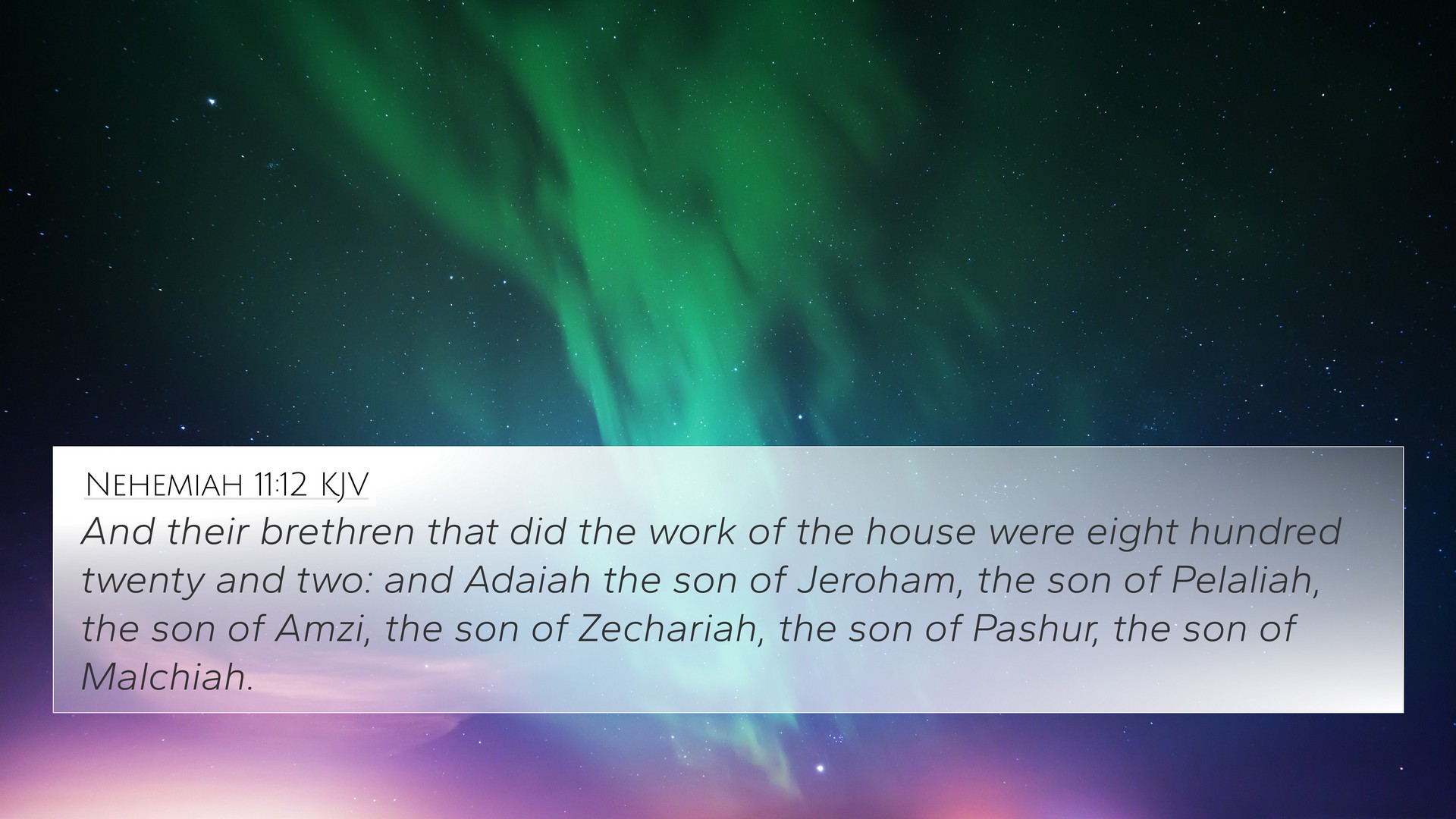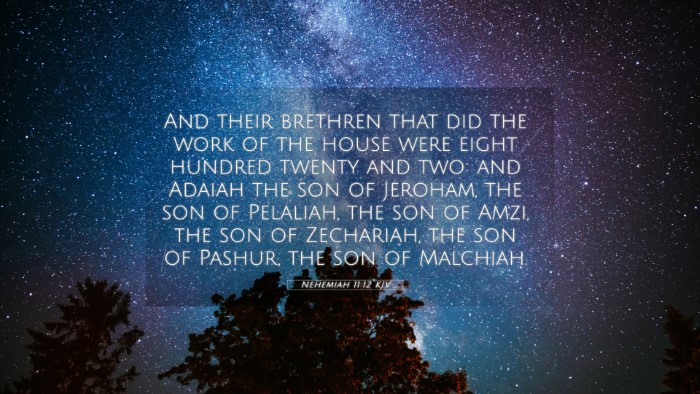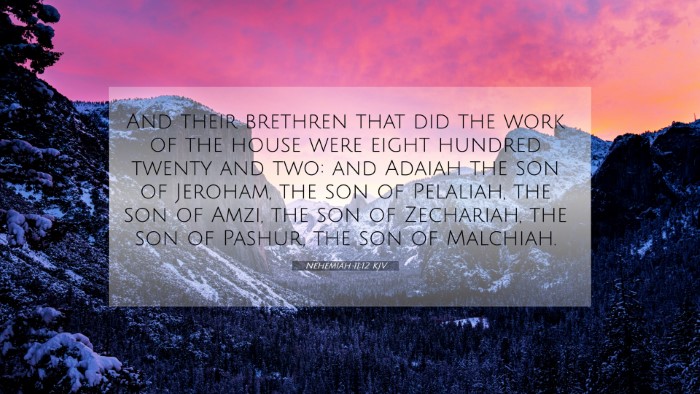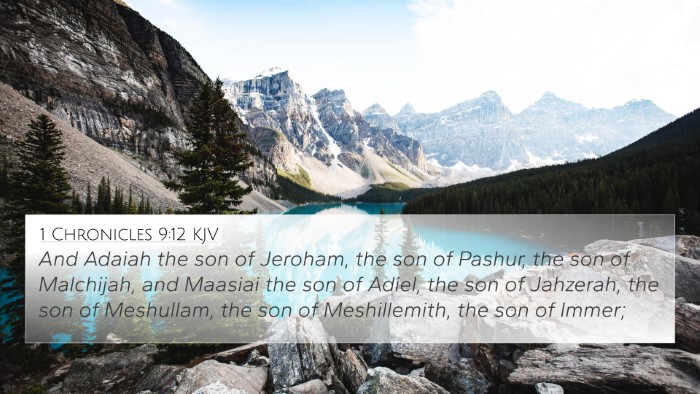Understanding Nehemiah 11:12
Nehemiah 11:12 reads: "And their brethren that did the work of the house were eight hundred twenty and two. And Adaiah the son of Jeroham, the son of Pelaliah, the son of Amzi, the son of Zechariah, the son of Pasher, the son of Malchiah, the son of Abishua, the son of Phinehas, the son of Eliashib, the son of Joiada, the son of Jonathan, the son of Jeshua, and the son of Jehozadak."
Contextual Background
The Book of Nehemiah details the return of the Jewish people to Jerusalem after the Babylonian Exile and their efforts to rebuild the city and its temple. Nehemiah 11 contains lists of individuals who took on the responsibility of building and populating the city, emphasizing the importance of community and service in restoring their homeland.
Insights from Public Domain Commentaries
- Matthew Henry's Commentary: Henry emphasizes the significance of the list of names, noting that it reflects the organization and dedication of the people in their task. Each individual is essential to the community, and this enumeration symbolizes God's provision and the restoration of Israel.
- Albert Barnes' Notes on the Bible: Barnes points out that this passage illustrates the lay leaders and priests involved in the temple work. He highlights how these laborers symbolize the continuity of worship and service as essential elements for the revitalization of the Jewish faith.
- Adam Clarke's Commentary: Clarke provides an in-depth genealogical perspective, stressing that the lineage connects to the priestly duties. He notes that the meticulous recording is part of preserving their heritage and emphasizes the importance of order and accountability in spiritual matters.
Thematic Insights
This verse can be reflective of several theological themes:
- Community and Service: The commitment of individuals highlights the importance of working together for a common purpose, which can be compared to 1 Corinthians 12:12-27, where Paul discusses the body of Christ and its diverse members functioning together.
- Restoration and Return: The act of returning to Jerusalem represents spiritual and physical restoration, akin to Isaiah 58:12, where God's promise is to restore the nations and individuals who work for the welfare of others.
- Lineage and Heritage: The genealogy emphasizes the significance of ancestry and God’s covenantal promises fulfilled through generations, paralleling with Matthew 1:1-17, which outlines the genealogy of Jesus Christ, affirming the continuity of God’s plan.
Cross-References for Nehemiah 11:12
Connecting Nehemiah 11:12 with other scripture can provide greater understanding. Here are relevant cross-references:
- Ezra 2:36-39 - This passage lists the priests that returned to Jerusalem, similar to the context of Nehemiah's chapter.
- Nehemiah 12:1-9 - A continuation of the listing of priests and Levites, influencing the worship protocols in the restored temple.
- 1 Chronicles 9:10-16 - Another list of priests, showing the continuity of priestly service across generations.
- Hebrews 7:14 - Discusses the priesthood of Jesus arising from Judah, connecting the Old Testament priesthood to New Covenant theology.
- Exodus 28:1 - Establishes the roles of Aaron and his sons as priests, showing the historical roots of the priestly function.
- Acts 4:36-37 - Highlights the early church's communal effort and generosity, drawing a parallel to Nehemiah's community focus.
- Revelation 1:6 - Indicates that believers are made into a kingdom and priests, linking the Old Testament's priestly heritage to the believer's current role.
Conclusion
Nehemiah 11:12 serves as a critical reminder of the importance of community and the individual's role within the larger structure of God’s plan. The rich genealogical context emphasizes heritage and continuity of worship, which are central themes throughout scripture. By engaging in cross-referencing, one can see not only the historical significance but also the profound theological connections that enrich one's faith journey.
Further Study and Research
For a deeper exploration of Nehemiah 11:12 and its implications:
- Utilize a Bible concordance or Bible cross-reference guide to find thematic connections.
- Engage in cross-reference Bible study methods to understand how various texts interact.
- Participate in group studies focusing on links between the Old and New Testament.



